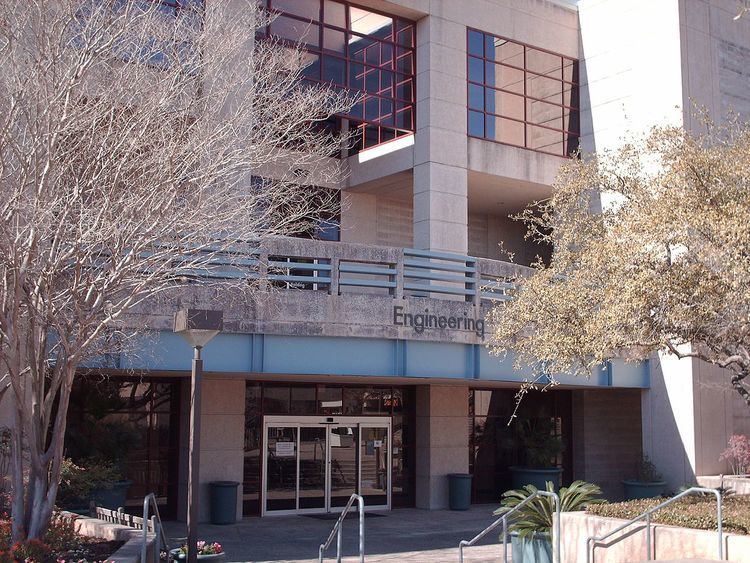 | ||
The University of Texas at San Antonio College of Engineering hosts undergraduate degrees in the fields of Electrical Engineering, Mechanical Engineering, Biomedical Engineering, Computer Engineering, and Civil Engineering. Graduate degrees are also offered in multiple areas, including Biomedical Engineering.
Contents
- Student organizations
- Student body
- Electrical engineering
- Mechanical engineering
- Civil engineering
- Biomedical engineering
- Facilities
- References
As College of Engineering students reach their senior year, they must choose a concentration. A concentration is a more specific area in one's field of study, where the student is required to take classes in that concentration. For electrical engineering, the concentrations offered are control systems, computer engineering, and communications.
The UTSA College of Engineering puts a heavy emphasis on engineering science and practical applications. Before graduation, an engineering student will have a firm foundation not only in the necessary mathematics, but also with computer applications that will be used in the engineering career field.
Student organizations
There are many student engineering organizations available to students. Some of the student branches of nationally known organizations are:
Student body
Electrical engineering students make up the larger portion of the engineering student body, followed by mechanical engineering students and then civil engineering students.
Electrical engineering
Electrical engineering faculty, funded by the Texas Higher Education Coordinating Board, conduct research in high performance multimedia processors and in muscle control using electromyographic signals. Research on 3-D spot counting is conducted in partnership with the Texas Engineering Experimental Station and on robotics and sensor based control and prognosis of complex distributed systems with the National Science Foundation.
The department is also working extensively in the areas of cyber security and homeland defense. Reliable and secure voice and data communications are important in mission success and in providing assurances to the public. Electromagnetic wave analysis regarding fallout may become necessary after a physical attack. Computer information security, high-speed intrusion detection, problem identification, reliable high-speed network design and redundancy are all important for cyber attack prevention; computer engineering faculty work with the Center for Infrastructure Assurance and Security in these efforts. Target analysis and radar signature identification help identify and track friends or foes.
Wireless communications that are hardened for recovery efforts are of great interest. An understanding of health physics is of particular importance in the case of nuclear and biological attack, and bio-MEMS (micro electromechanical systems) are used increasingly in health monitoring in such instances. Additionally, the doctoral program in Electrical Engineering focuses on communications, control, signal processing, and computers.
Mechanical engineering
Mechanical engineering faculty are working on topics such as nanotechnology and biomechanical systems, micro-electro-mechanical systems, nano-electro-mechanical systems, and mechatronics.
Civil engineering
Civil engineering faculty work with the Texas Department of Transportation to provide measures to improve truck safety, to develop methods and materials to accelerate construction and opening of PCC pavements, and to establish processes for equipment replacement. Additionally, transportation engineering and infrastructure management research allows for optimization and redundancy in transportation systems.
Working with the Center for Water Research, additional research into water quality and the more efficient use of water is being conducted. The new doctoral program in Environmental Science and Engineering emphasizes natural resources, and engineering faculty work with geologists, environmental scientists, chemists, and hydrogeologists. Research areas include environmental analysis, restoration, and water resource research focuses on recovery and remediation, especially in understanding the fate and transport of surface and groundwater pollutants.
Biomedical engineering
Biomedical engineering faculty work on topics such as the contribution of Type I collagen to mechanical properties of bone, importance of permeability in tissue engineering scaffolds, post-yield behavior of cortical bone, strengthening bioresorbable polymers, surface modification via formation of organic ultra thin films, and cell proliferation on scaffolds.
Facilities
The Biotechnology, Sciences and Engineering building opened in 2006, and hosts new opportunities for engineering students. The building has also received recognition in the architecture community for its design and purpose. The offices of biotechnology, civil engineering, and electrical engineering department members are located here. Research is being heavily done in the areas of MEMS, photonics, and digital image processing.
The original engineering building offers multiple computer labs, a microcomputer lab, a lab with Sun Microsystems computers for a course in digital systems design, and two labs for students in practical, hands-on courses. The original building serves as the location for the mechanical engineering faculty offices as well.
According to the master plan of UTSA, the university is expecting to receive another large engineering building, and new research facilities located on the east side of the campus by the year 2030. Special housing options would also be available for students doing research for the university.
The newest addition, is the Applied Engineering & Technology (AET) Building. It was recently opened fall of 2009, and includes a student study space, research labs, and interactive learning classrooms.
